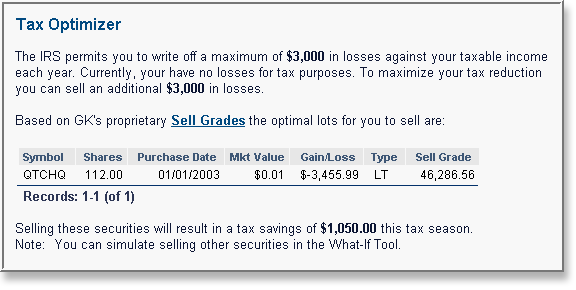|
When evaluating investment performance, many people focus on the return of
individual securities. Naturally, investors always hope that the securities
they own will eventually be sold for more than the original price they paid.
But to focus solely on market prices and returns is a mistake. When you stop to
consider that the IRS will take up to 35% of your investment gains, a 10% gain
suddenly doesn't seem as exciting. It's at this point that the power of
tax-smart investing becomes clear. |
|
||
If your portfolio has both realized gains and unrealized losses, harvesting some
of those unrealized losses to offset capital gains can substantially reduce
your tax liability. In fact, since the IRS allows investors to write-off up to
$3,000 in losses, it may still be wise for you to realize losses if you have
net losses but haven't yet reached the $3,000 threshold. Our Year-End Tax
Optimizer can help you make the right moves.

GainsAdvisor Helps You Leverage these Tax-Smart Trading Strategies
- Managing Short- and Long-Term Gains. Take advantage of the significant difference in short-term and long-term capital gains tax rates (up to 35% versus 5%–15%). The tax savings can be significant.
- Selling Partial Positions Using Specific ID. The IRS requires FIFO (first-in, first-out) to be used if a specific lot is not identified for sale. However, in most instances it's wiser to sell shares that have the highest unit cost, thereby minimizing gains and the tax burden. Even mutual funds can be sold using specific ID rather than average cost.
- Avoiding Wash Sales. A wash sale occurs when a security is sold for a loss and repurchased within 30 days of the sale. A wash sale is usually triggered by a buy transaction, but complicated tax rules say that a wash sale can even occur when selling a security within 30 days of buying that same security. GainsKeeper tracks wash sales when they occur and helps investors avoid them in the future.
- Doubling Down to Lower Your Cost Basis. Investors often hold securities with deeply imbedded losses because they want to remain long in the market. By doubling up your position in that security at today's lower price, and waiting more than 30 days to sell the original lot, you can effectively lower your cost basis without incurring a wash sale.
- Realizing Gains Without Any Tax Consequences. Sounds like a dream, doesn't it? But, if you have more than $3,000 in realized losses you can take gains without incurring cap gains taxes. GainsKeeper's reports make this easy.
- Gifting a Stock. Always gift stock lots with lower cost basis and short-term gains (if possible) and keep the higher cost, longer-term lots. This will save you real tax dollars in the long run.
- Deferring Taxes. A basic principle of finance is "a dollar today is worth more than a dollar tomorrow." The tax version of this principle is "paying taxes in the future is better than paying them now." If possible, hold off from taking gains until next year. That way you can defer taxes on that gain for one full year.